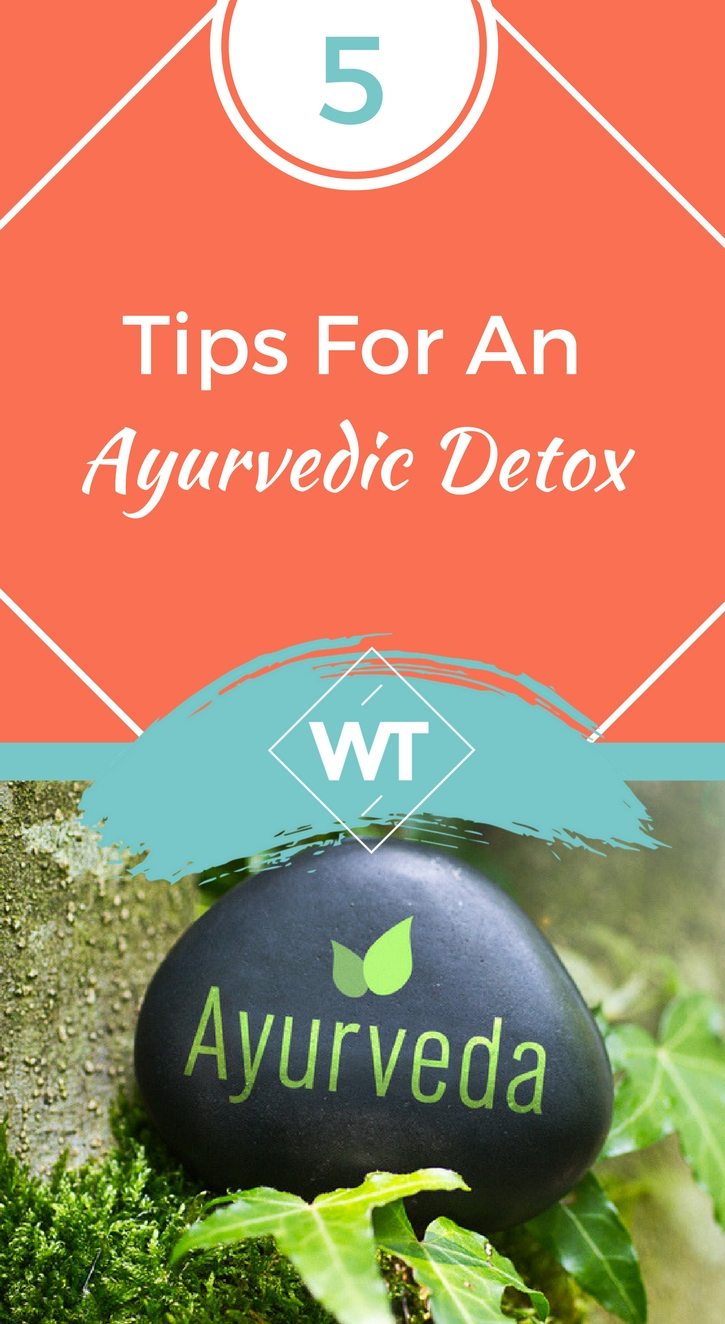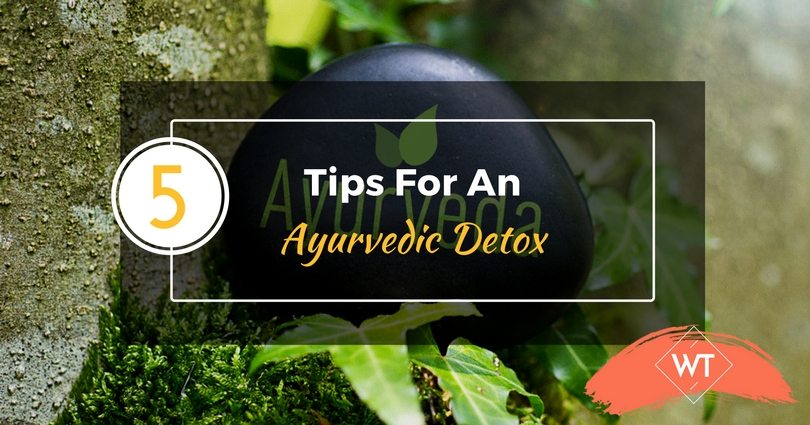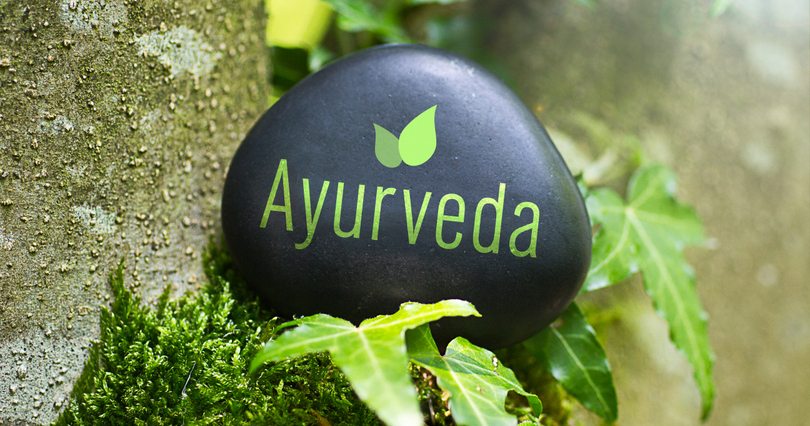5 Tips For An Ayurvedic Detox

If you’ve never heard of Ayurveda then chances are it sounds a bit intimidating. However, out of all the information on health and wellness, the wisdom of Ayurvedic Medicine is perhaps some of the simplest.
It’s difficult to find good, honest data on the subject of health these days. The Internet and libraries are filled with millions of opinions from people of all types. Much of this information though is fragmented and offers only a glimmer of the big picture.
What’s more is that a lot of these concepts try to suggest there is a one-sized-fits-all approach. This simply doesn’t work because each one of us, while similar, are very unique individuals. This is why I enjoy Ayurveda so much. The practitioners of Ayurveda help each individual find a custom diet and lifestyle that brings their own unique constitution into balance; free of any dogmas.
With just a little bit of study, Ayurvedic wisdom is something anyone can understand, put to practice, and enjoy. With just a few daily ceremonies incorporated into your day you will find that you can prevent sickness and disease with an Ayurvedic detox and then after, cultivate plenty of health with far greater ease than previously thought.
What is Ayurveda?
In studying any subject, it’s important to understand the terminology of that subject. Misunderstood words can be a major cause of confusion in study. With so many uncommon words in the health world, it’s imperative we clear up this confusion to better understand the subject of health.
That being said, the word Ayurveda literally translates as the science of life. As with any form of science, it is not static but instead a moving and evolving subject. Ayurveda is a form of holistic medicine that is over 5,000 years old.
Holistic means whole and as a practice of medicine, holistic health views the body as a whole, rather than in fragments or symptoms. Ayurveda specifically sees the body as a microcosm of nature and the entire universe. From that view, practitioners of Ayurveda use the laws and wisdom of nature to better understand ourselves.
According to Ayurvedic wisdom, our unique bodies and all of Mother Nature consist of a combination of these five central elements: Space, Air, Fire, Water and Earth. Together, these elements make up our unique body types. This unique blueprint is referred to as our Dosha.
Your Dosha
A simple quiz with an Ayurvedic practitioner can help you discover your primary Dosha. This will help you to determine particular lifestyle and nutritional choices that will bring about balance and optimal wellness. Upon taking your quiz you will discover that there are three main Doshas: Vata, Pitta and Kapha.
A quick description reveals that each Dosha has specific traits:
Vata: The Vata energy controls bodily functions that are correlated with motion. This includes blood circulation, breathing, and the heartbeat. When Vata is in balance there is ample creativity and vitality. When out of balance an individual can experience fear, anxiety and hyperactivity.
Pitta: The Pitta energy controls the metabolic system. This includes digestion, absorption, nutrition, and body temperature. When Pitta is in balance an individual has strong digestion, is content and mentally sharp. When out of balance an individual can experience digestive problems, especially ulcers and excess heat in the body causing inflammation and on an emotional level, anger and irritability.
Kapha: The Kapha energy controls the body’s growth by supplying water to all parts of the body. Kapha also helps to maintain the immune system. When Kapha energy is in balance the skin is healthy and emotionally an individual is capable of love and forgiveness. When out of balance the body can become overweight, constipated or diabetic. Emotionally an individual can hold onto things too long, they can become insecure and depressed.
You can find a simple quiz online to take or consult with an experienced Ayurvedic practitioner to uncover your Dosha.
5 Cleansing tips for an Ayurvedic detox
Once you know your Dosha you will be well on your way to creating a lifetime of balance and harmony in the body, starting of course, with you Ayurvedic detox. Aside from having a better understanding of your unique body, there are some simple and effective practices that can help everyone aid their body in achieving balance daily. Each of these practices helps the body’s internal purification system. Best of all, they are simple and can be implemented into anyone’s routine. Here are a few Ayurvedic detox tips you can start practicing today.
1. Warm lemon water in the morning
Lemon has bitter qualities that stimulate the vagus nerve to flush bile from the gallbladder. It is also a digestive stimulant that encourages regular elimination. Consuming warm lemon water first thing in the morning will get the body detoxifying before you start your day so you can feel clear and balanced all day. Squeeze the juice of 1/2 a lemon into a cup of warm water.
2. Tongue scraping
Here’s one Ayurvedic detox routine that once you try, you can’t go back! If you’ve never noticed your tongue in the morning, it can be quite filthy (depending on your toxic load). In Ayurveda we learn a lot about the signals the body gives off and what they mean.
The condition of our tongue actually says quite a bit. It can even communicate to us on how to best start our day. A healthy body with properly functioning organs and digestive tract will have a healthy looking, pink tongue. If the body is clogged with toxins and undigested food (or if the organs are not functioning well) then the tongue can have a coating on it, or have some other sort of abnormalities.
If this is the case, then all the more reason to start your day with tip number one of your Ayurvedic detox. If persistent you may even opt for a full-body purification. You can, at a minimum, at least begin to scrape off the toxins from your tongue so they are not recirculating into the body.
You can purchase a tongue scraper from just about any health food store. If you can’t find one, you can always use a steel spoon. Be sure to get a stainless steel one so it won’t rust. To perform (of course do this first thing in the morning upon waking before you eat or drink) gently scrape the tongue, from the back to front. One or two good passes will generally do; however, you can take as many as you need to feel clean.
3. Keep breakfast light
Digestion is at its weakest in the morning and at night, therefore, we want to wake up the digestive system before we start eating any heavy foods. In general, it’s good to start the day with something light and easier to digest and then save our biggest meal for lunch, when digestion is strongest.
Keeping the digestive system from overworking is essential for preventing toxic build up. One of the best breakfast options would be a hydrating green smoothie. Because the body becomes dehydrated while sleeping, it’s appropriate to start hydrating the body in the morning.
A green smoothie offers plenty of minerals and water to hydrate the body, which supports our Ayurvedic detox even further. There is a bit of an art to making green smoothies though. It’s best to avoid using raw cruciferous vegetables because they can suppress the thyroid and also, we want to keep sugar (fruit included) to a minimum so we do not spike the blood sugar early on in the day—this can set us up for energy imbalances later on.
When it comes to diet and Ayurveda, there is plenty of emphasis on seasonal eating. Different foods are more appropriate depending on the season. During the Fall nature becomes dry, rough and cold. If we eat too many foods with these qualities it can create an imbalance in the body. That is why hydrating and warm foods like soups are so wonderfully balancing in the Fall and Winter months.
For optimal health, it’s best to steer clear of foods with too strong of these qualities. It would be best to have a modified version of a standard green smoothie during the Fall.
Here’s a Fall-inspired green smoothie recipe to energize you and help you with your Ayurvedic detox:
Ingredients:
- 1 cup homemade coconut milk
- 1 zucchini
- 1 medium avocado
- 1 tbsp. chia seeds (soaked)
- 2 tsp. powdered ginger
- 1 tbsp. chlorella
- 1 tbsp. goji berries
- Stevia to sweeten
Directions:
Put ingredients into a high-speed blender and mix until creamy. Add Stevia for more sweetness or spice for more pep.
4. Eat more sweet, sour, and salty food
Fall is Vata season, which means dryness, roughness, cold, and subtle movement. In order to preserve balance in our bodies we have to avoid eating foods with these same qualities. Instead, we will feel more balanced if we consume more hydrating, grounding, and warming foods. Typically, foods that are on the sweet and salty side as well as foods that are sour will fit this bill. Here are a few examples:
- Fresh sweet fruits like coconut, apples, and pears (seasonal Fall fruits).
- Fresh sour fruits like cherries, cranberries, pomegranate and lemon or limes.
- Root vegetables like beets, sweet potatoes, carrots and winter squash.
5. Try oil massages
Not only do oil massages feel amazing, they actually calm the nervous system and nourish the skin. The skin has thousands of nerve endings that are connected to the nervous system. That is why massages feel so good. In fact, a hug releases more oxytocin (the love brain chemical) than any food! If you can’t find a hug nearby then definitely try this self-care practice.
Still give your hugs but also give yourself a little loving as well!
Oil massages using sesame or coconut oil also help remove impurities from the blood. That is because the skin is the largest detoxification organ in the body. The skin serves to protect the internal body from the effects of the environment. Helping keep it healthy will help keep the entire body healthy.
Before you dive into your massage, consider these oil options which will help balance each constitution more specifically:
- Vata: sesame or almond oil
- Pitta: coconut or olive oil
- Kapha: sunflower or grapeseed oil
Tip: Always use organic, unrefined and cold-pressed oils when rubbing them directly onto your skin. Whatever is put on the skin is directly passed into the liver via the bloodstream. We want to make sure whatever goes on the skin is pure!
You can administer your oil massage however you want. I suggest setting yourself up in a candlelit bathroom with some soft music. You can get in the shower and sit away from the water. Put the water on hot to open up the pores and to help the oils get into the skin and nourish the inner tissues. Doing it in the shower will also prevent any oil spills! You can also just lay a towel down, whatever sounds nice to you!
Also, gently heating the oil will make for a more pleasurable experience and allow for the oils to deeper penetrate the skin. Simply place your oil in a glass container or a bottle then let it sit in hot water until the oil is warm.
There’s no right or wrong way to massage yourself, just make sure you cover all bases and it feels good. Traditionally though, most oil massages in Panchakarama resorts are done with the palms and fingers and worked in a circular motion over the joints and abdomen. You can also use up and down strokes over the length of your limbs and work the oil into the hands, feet and scalp.
When you are finished, let the oil sit for 15-30 minutes and get into a hot shower or Epsom salt bath to get the oil in and then rinse off the skin.
Hopefully you find these Ayurvedic detox tips as empowering and enjoyable as I have found them to be throughout my practice!









Leave a Reply